
Knowledge Hub
Bangladesh is one of the most vulnerable countries to climate change in the world. However, its communities, with the help of Concern, are defying the odds with climate-smart techniques that allow them to grow nutritious food, whatever the weather.
Bangladesh ranks first in the world in terms of vulnerability to tropical cyclones, and each year the country is subject to devastating cyclones and floods. Flash flooding destroys crops, increases the salinity of the water and kills livestock. The number of people displaced from their homes in Bangladesh because of climate change is predicted to rise to one in seven of the population by 2050 [BBC]. Such climate change vulnerability also makes growing food and earning a living very difficult.
Thankfully, communities in Bangladesh are quick to adapt and hone new climate-smart techniques that not only make their lives easier, but saves them too.
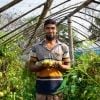
Saline water is a huge problem, and every time there is a flood or another disaster, it worsens. So, what we have learned is that we have to apply different techniques.
What is climate-smart agriculture?
Climate-smart agriculture is a set of both new and old agricultural practices that are considered effective in helping farmers adapt to climate change and – among some groups – to mitigate climate change. Such techniques in Bangladesh draw on traditional practices like the Sorjan system (tall beds for vegetable and crop production alternating with furrows suitable for the submergence of stress tolerant crops and fish production) as well as new practices like vertical gardens.
The climate-smart agriculture techniques
The Tower Technique
The tower technique is also known as vertical growing, and is a popular form of climate smart agriculture in Bangladesh.
The vertical growing structure is made from bamboo, and the idea is simple: you grow your produce up the structure to keep it off the ground where it is vulnerable to floods, saline water and other climate-induced problems. Mixing compost and/or cow dung with soil helps with moisture conservation to reduce irrigation costs and the seeds or seedlings are planted on the soil surface, with the sack placed at the homestead in an area that is exposed to sunlight and not prone to flooding during the rainy season.
Hosenare uses the tower technique, which she learnt during the training.

Hosenare either cooks her produce grown for her family, or sells the excess at the market.
The Floating Technique
Floating bed cultivation of vegetables are becoming increasingly popular in the low-lying southern districts of Bangladesh, such as Bagerhat. Typically introduced in flood-prone areas, this revival of an age-old technique allows farmers to grow vegetables in water – even as the water level increases.
Usually, bamboo is laid on a dense layer of water hyacinth. The first layer acts as the base of the floating bed and maintains the stability, buoyancy and thickness of the bed. Above layers are used as compost. After 8-10 days, farmers sow and transplant the seeds/seedlings already germinated.
Two or three crop rotation cycles on floating gardens during one monsoon season are common. In the following winter, the floating beds are decomposed and the residue is used to enrich the soil for winter vegetable cultivation. [FAO]
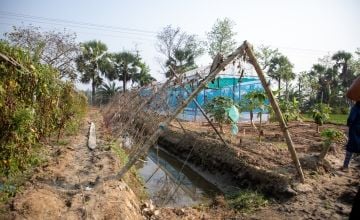
When the water level will increase, [the crop] will be floating automatically.
Bed system
Another tried and tested climate smart agriculture method uses the elevation of natural land, with no above-ground structure, to facilitate drainage. With special pit-digging methods, or, on the opposite end of the spectrum, raised mounds of earth, to collect, divert, or slow down the flow of water during seasonal rainfalls, these simple interventions can reduce water loss as well as soil erosion.
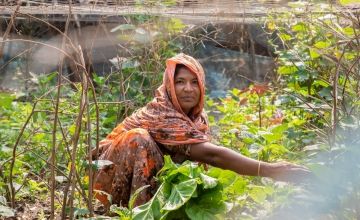
These raised beds can also be separated by a trench for even better drainage.
Sack gardens
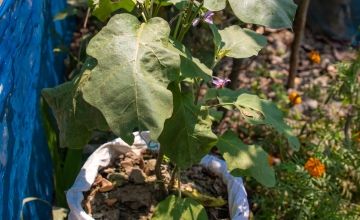
Gardens that are planted vertically on the sides and tops of grain sacks filled with soil are known as sack gardens. These are a brilliant solution for places with limited access to space, water and time.
The sacks take a small amount of space and the plants grown within them do not need large amount of water as the soil is packed in the sack and water does not disperse underground. Sack management is easier and requires less labour compared to growing vegetables in the traditional way, due to less travel fetching water and less bending over to tend to the plants. This is particularly beneficial for women, on which the majority tasks tend to fall.
Trellis growing
Trellis growing is similar to bed planting and vertical growing, except here, a horizontal bamboo structure or a bamboo framed structure is erected around the pits or sacks that will later support the canopy of the creeping vegetables.
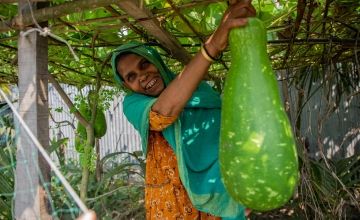
There are many more climate smart agriculture techniques such as crop diversification, seed systems and agroforestry that are used and taught throughout our programmes.
What have these climate-smart techniques achieved?
Climate-smart solutions will not solve climate change; but they can certainly help those impacted the most live better and healthier lives.
As you can see from the stories told in amongst the techniques used in Bangladesh, they really are making a difference to people’s lives. But don’t take our word for it. Read their stories in more detail here.
Other ways to help
Donate now
Give a one-off, or a monthly, donation today.
Join an event
From mountain trekking to marathon running, join us for one of our many exciting outdoor events!
Buy a gift
With an extensive range of alternative gifts, we have something to suit everybody.
Leave a gift in your will
Leave the world a better place with a life-changing legacy.
Become a corporate supporter
We partner with a range of organisations that share our passion and the results have been fantastic.
Create your own fundraising event
Raise money for Concern by organising your own charity fundraising event.





